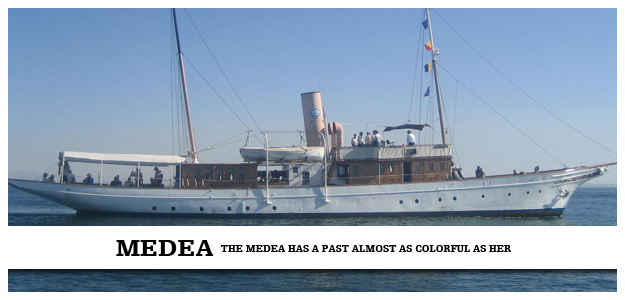
A Century Old And Built Of Oak, Teak And Steel.
Medea
Named after a Greek mythological figure, the Medea has a past almost as colorful as her namesake. Originally, the steam yacht was built in 1904 for William Macalister Hall of Torrisdale Castle, Scotland. Built of steel and furnished with imported teak and quarter-sawn oak, the Medea is an impressive and beautiful little boat. Macalister Hall, a wealthy landowner and British Army officer, used Medea mainly for social occasions and hunting trips around the isles and lochs of western Scotland. By the beginning of World War I, she was in the hands of the man who built her, John Stephen. Later during the war, she was purchased by the French Navy and converted to a gunboat named Corneille. Armed with a 75mm gun, depth charges and an observation balloon, she operated as a convoy escort for French sailing ships. After the war she resumed her old name and returned to British colors. Owned by members of the Parliament, she often cruised the Mediterranean Sea.
Early in World War II, Medea joined the Royal Navy as a barrage balloon vessel at the mouth of the River Thames. Later she went back to Scotland and was used by the Norwegian Navy, based there as an accommodation ship for Norwegian commando officers.
By 1946 Medea was back in British civilian service, cruising off Cornwall and the Isle of Wight. During the 1950’s and 1960’s, she had four different owners, including Job Longson Wild, her owner prior to World War II. In those post-war years she served at her owners’ pleasures. From 1966 to 1969 she was in charter service, until her Swedish owners took over in 1969. By that time, Medea was a tired old boat, but she was still pretty enough to capture the attention of oilman Paul Whittier, who had steamed aboard similar vessels in his youth. In 1971, Whittier purchased, restored and donated Medea to the Maritime Museum of San Diego. This amazing gift arrived in San Diego on July 14, 1973.
Today Medea still cruises the Bay on special excursion cruises for invited guests. Although she is not permitted to carry paying passengers, she is open dockside to welcome all visitors to the Maritime Museum.
- Medea was constructed in a record building time of 51 days
- She was launched with steam up in her boiler
- Built with a coal-fired boiler, Medea was converted to oil in 1964
- Medea has served in two world wars, under three navies and six national flags
- A book on Medea’s history is available at our on-line store
| LOA | 134’ |
| Beam | 17’ |
| Maximum Draft | 8’ |
| Engine | 2 cylinder compound reciprocating steam engine, 254 hp |
| Gross Tonnage | 143 |
| Cruising Speed | 8.5-10 knots |
